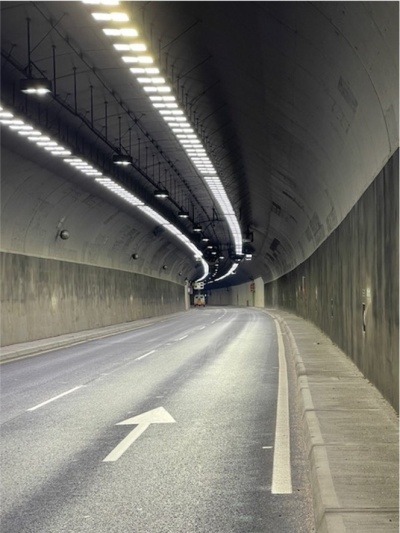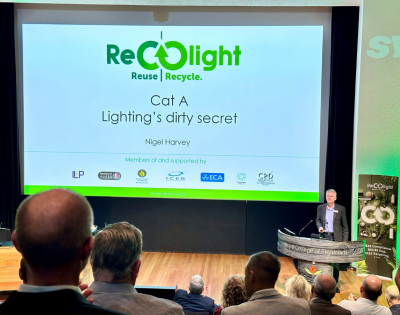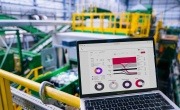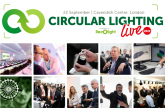Light at the end of the tunnel: Remanufactured lighting equipment
Despite often going under the radar, millions of pieces of waste lighting equipment end up in UK landfills each year. Moves are finally being made to make the lighting industry more circular, but what does this entail? And what are the environmental and economic benefits to businesses that adopt such practices?
 In 2019, over 40,000 tonnes of lighting equipment was placed on the market with only 2,700 tonnes collected by WEEE scheme operators.
In 2019, over 40,000 tonnes of lighting equipment was placed on the market with only 2,700 tonnes collected by WEEE scheme operators.
Alongside this, research from Material Focus has uncovered that over 29 million LED, solar and decorative lights end up in UK landfill sites each year.
The issue of lighting reaching landfill is compounded by the fact that many pieces of waste lighting equipment arriving at landfill are hazardous. Fluorescent lighting – which typically includes energy-saving bulbs and lighting tubes – often contains mercury and is therefore classified as hazardous waste under the WEEE Directive adopted by both the European Union (EU) and the UK.
As a result, lighting equipment is a danger to the environment and human health, with the risk of hazardous materials contaminating the air, soil and groundwater.
Lighting remanufacture provides a safer and more sustainable alternative to this. The process involves disassembling used lighting fixtures, repairing or replacing components, and then reassembling them to a condition that is as good as, or better than, new. By extending the life cycle of products and reducing electronic waste, this helps contribute to fostering more circular practices in the industry.
Reconditioned lights are often updated with newer energy-efficient components, lowering the resources required to create and use them. Using remanufactured lights over new equipment also reduces the demand for material extraction and processing, providing a significant environmental advantage over other methods such as recycling.
According to lighting compliance specialists Recolight there is robust evidence that a typical lighting product is half the embedded carbon of a new product. That is a major carbon saving that we should all be seeking to achieve.
Remanufacture: Keeping the lights on
The process of remanufacturing lighting begins with the collection and disassembly of used lighting fixtures. Here, the luminaire will be assessed to determine its suitability for resale or remodelling. If new, unused or in a resellable condition alongside supporting Original Equipment Manufacturer (OEM) data – that includes information such as the electrical characteristics and materials used for the product – the product is then suitable for reuse should it comply with regulatory standards.
In the absence of this data, the luminaire will undergo minor alterations – such as cleaning or cosmetic – to recondition the product and ensure regulatory compliance before installation and use.
In scenarios where luminaires are not in a new condition, the products are then assessed for their ability to be remodelled. If remodelling is not possible, components are harvested by a WEEE scheme prior to recycling.
Where remodelling is possible, major material changes to remanufacture the luminaire are undertaken to ensure its safety before it is reinstalled.
Following a circular model, reused products are then reassessed at the end of their life cycle, repeating the loop whereby the luminaires can be remanufactured into new products.
Regarding the types of lighting that are frequently remanufactured, fluorescent lights are often upgraded to more energy-efficient LEDs – a growing trend following the UK’s ban on T5 and T8 fluorescent tubes in September 2023.
At the end-of-life recovery phase, several criteria must be met to ensure the suitability of the transition from fluorescent to LED. This includes aspects such as the structural integrity of the lighting fixture as well as the quality of the original components – for example, the housing and diffusers.
The remanufacturing process then involves the removal of the fluorescent lamp and ballast before replacement with a new LED lamp and driver, creating a more future-proof and cost-efficient lighting system.
It is estimated that businesses with fluorescent fixtures that opt for this remanufacturing process can reduce costs by on average 40 per cent in comparison to purchasing new replacements.

The primary objective was to replace the existing lighting with LED alternatives, a decision driven by the increasing need for energy conservation and cost savings. The retrofit included the replacement of 1,800 lights, leading to a significant reduction in energy consumption by approximately 60 per cent.
As well as the reduced environmental impacts, this led to a saving of over €4 million in electricity costs over a five-year period. Moreover, by reusing existing light fittings, the project managed to save around €3 million compared to the costs of a complete overhaul with new LED infrastructure.
Standards for remanufactured products
To ensure the quality and safety of remanufactured lighting products, BS 8887 – the British standard for the manufacture, assembly, disassembly and end-of-life processing of products – provides guidance to manufacturers and designers in the sector.
The standard covers all aspects of the remanufacturing process, from the initial collection to the assembly of the final product, aiming to ensure that consumers receive a product that is as good as new whilst reducing their costs and environmental impact.
Commenting on the value of the standard, Simon Fisher, Director of design company F Mark, explained: “BS 8887 is a comprehensive document and helps to define minimum expectations that specifiers should have with regards to quality and reliability of remanufactured products and that OEMs should apply when conducting a conversion to a pre-owned product.
“It's vitally important to demonstrate that, whilst pre-owned, the quality and performance of a remanufactured luminaire will not be compromised.
“BS 8887, and remanufacturing in general, holds the key to huge energy and carbon reductions, whilst preventing a huge quantity of material entering the e-waste stream (if we are lucky). Our industry, like every other, has an obligation to do everything we can to mitigate the climate crisis we are living in. BS8887 sets the framework to deliver safe and reliable remanufactured products to the market, delivering confidence to the specifier or end user that the product is ‘as good as new’”.
Whilst standards like the BS8887 framework help set guidelines for remanufactured lighting equipment, Fisher notes that it is businesses that are driving the change to circularity.
He added: “The lighting industry has made good progress with regards to embracing circular economy and sustainability in general. There is legislation in place (Ecodesign guidelines) to drive change but, in all honesty, the tail is wagging the dog in terms of this topic.
“Designers and manufacturers are generally going above and beyond what is technically required by law to design and offer the best possible sustainable solutions to the marketplace”
Scaling up environmental impact
Modularity and interoperability are pivotal concepts to facilitate the widespread adoption of remanufactured lighting.
The concept of modularity denotes the use of standardised structural elements with defined functions and characteristics that can be interchanged with similar or corresponding components. This is a crucial concept for achieving circularity – increased modularity improves the adaptability and upgradability of a product, allowing reconfiguration to meet changing technological needs over time.
Permitting the easy repair, removal and replacement of individual components eliminates the need to discard entire products – this increases the lifespan of lighting products while simultaneously leading to reduced electronic waste.
Similarly, interoperability refers to the ability of various lighting components, systems, and technologies to work seamlessly together, even if they are produced by different manufacturers or are different models. With high interoperability, lighting components that would have otherwise been discarded due to not fitting a particular system can be repurposed, once again reducing waste and facilitating more widespread reuse of parts.
An example of increasing interoperability to create a future-ready system can be seen through lighting remanufacturer Silent Design’s project at the Building Crafts College in London.
The company removed a total of 350 T8, T5 and compact fluorescent lights – originally considered waste – from an unfurnished South Bank office before testing and upgrading the lights. The lights were then converted to LED before installation and use at the Building Crafts College.
The lighting system is controlled by Casambi – a Bluetooth-based lighting control system that is run using a dedicated app – which minimises the need for the installation of new hardware. Using the system has also ensured the project is future-proof, providing interoperability as the wireless controls are available from several suppliers.
According to John Bowden, Director at Silent Design, the transition from fluorescent to LED lighting has driven energy savings of at least 50 per cent. This is compounded by the use of the Casambi system – which allows presence and daylight dimming – which saves a further 30 per cent.
On top of this, the system used a cloud-based graphics interface to monitor the health of lighting, flagging faults if they occur. The interface also monitors the energy used for the project’s installation and provides insights to the user on the energy savings in comparison to the prior installations. According to John Bowden, the system is currently showing an 82 per cent total energy saving against the previous install.

Explaining this, Bowden said: “Along with the energy-saving metrics of the project we thought about the entire project with regards to waste, transport and reuse of the existing lights.
“For transportation, we did not use any packaging waste. Lighting that could be transported to our workshop was done with no tape and no cardboard packaging. It was instead done with reclaimed carpet tiles that we acquired from a previous job. We used the carpet as packing between the lights. The tiles were then stored ready for the next retrofit project so no waste was generated. The hard-to-remove continuous lighting was retrofitted in situ meaning little carbon emissions for these types. Minimal waste was the key to this project's ultra-low carbon credentials.
“The lighting that was replaced with the reclaimed lights were either upgraded and repurposed into new locations in the college, or broken down on site and separated into parts for plastic or metal recycling. The whole project has been carefully considered from not just the lighting but the transport and waste aspects as well.”
The benefits of remanufactured lighting
Employing the West of England Low Carbon Challenge Fund, the Holburne Museum in Bath undertook a review of its energy use with the objective of cutting its environmental impact and costs. Highlighted by the review, lighting was revealed to be a key driver of the museum’s energy use and subsequent carbon footprint.
Following securing funding from The Wolfson Foundation to retrofit the building’s lighting system, the decision was made to use Stoane Lighting's ReNew service for the remanufacturing of the lighting.
The museum’s original 300 MR7 track spotlights used MR16 halogen lamps – which became prohibited on the UK market in October 2021. Each light within the system possessed a maximum power consumption of 50W.
Remanufacturing the existing luminaires and converting the existing halogen lights to LED, the lights now have a maximum power consumption of 10W, helping lower the museum’s operational costs.
By opting to remanufacture the existing lighting equipment, the Holburne Museum was able to reduce the embodied carbon associated with manufacturing new luminaires. The original MR7s embodied carbon was assessed at 34.3 kgCO2e per unit. The process of remanufacturing the system to LEDs, added 11.7 kgCO2e per unit to the embodied carbon, overall, achieving a saving of 23 kgCO2e per unit in comparison to manufacturing a new luminaire. In total, this resulted in a saving of 6900 kgCO2e across the entire project.
The project also retained 70 per cent of the original product weight, minimising the necessity for material extraction, manufacturing and transportation, whilst mitigating the additional electrical waste that would have been generated from disposing of the system’s original components.
Overcoming barriers
Despite the significant progress made in the realm of remanufactured lighting, clear challenges remain in the way.
A key barrier remains that not all previously installed lighting systems are suitable for disassembly and remanufacturing. Until this becomes more widespread – and modularity and interoperability become the norm – the opportunities for remanufacture in the lighting sector will continue to be hindered.
A further barrier is – much like in other circular practices – continued stigmas surrounding repurposed goods. There remains a general perception amongst consumers that second-hand equipment signifies a lower standard and therefore demand for such products is viewed as low by many in the industry.
Though obstacles remain in place, the future looks bright for reconditioned lighting. Recolight demonstrated during their ‘Circular Lighting Live 2023’ conference earlier this year a notable rise in UK companies opting to reuse luminaires.

This growth is being driven by new platforms for the sector, such as Recolight’s Reuse Hub. The Hub is a digital marketplace – that notifies remanufacturers when used stock is available – promoting the donation of new and used lighting products and equipment, avoiding unnecessary recycling by making it as easy as possible for donors to hand over products to third-party users who can put them to good use.
Alongside concerted efforts from the industry like this, the success of remanufactured lighting hinges on embracing modularity and interoperability in design, fostering a conducive environment for circular economy practices.
Economically, businesses will benefit from cost savings, while environmentally, the reduction in material extraction, manufacturing and waste can contribute to a substantial carbon footprint reduction.
The ability to remanufacture lighting on a wide scale is already available. Going forward the challenge will be for premises and project managers to leverage any opportunities to incorporate these environmental and economic gains where possible.
To find out more visit Recolight’s Reuse Hub.







